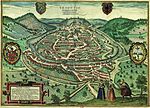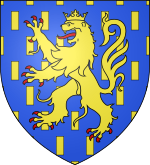Besançon-Viotte station
Bourgogne-Franche-Comté geography stubsFrench railway station stubsRailway stations in DoubsRailway stations in France opened in 1855

Besançon-Viotte is the main railway station located in Besançon, Doubs, eastern France. The station was opened in 1855 and is located on the Dole–Belfort railway, Besançon–Le Locle railway and Besançon-Viotte-Vesoul railway. The train services are operated by SNCF. Besançon Franche-Comté TGV is a high speed station located 10km north of Besançon.
Excerpt from the Wikipedia article Besançon-Viotte station (License: CC BY-SA 3.0, Authors, Images).Besançon-Viotte station
Espace Maréchal Juin, Besançon Rue Battant
Geographical coordinates (GPS) Address Nearby Places Show on map
Geographical coordinates (GPS)
| Latitude | Longitude |
|---|---|
| N 47.246944444444 ° | E 6.0219444444444 ° |
Address
Espace Maréchal Juin
25000 Besançon, Rue Battant
Bourgogne-Franche-Comté, France
Open on Google Maps










